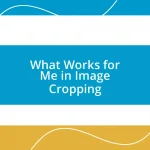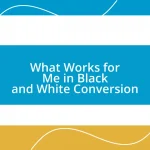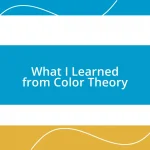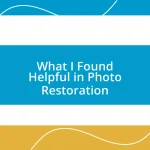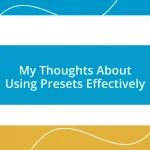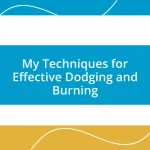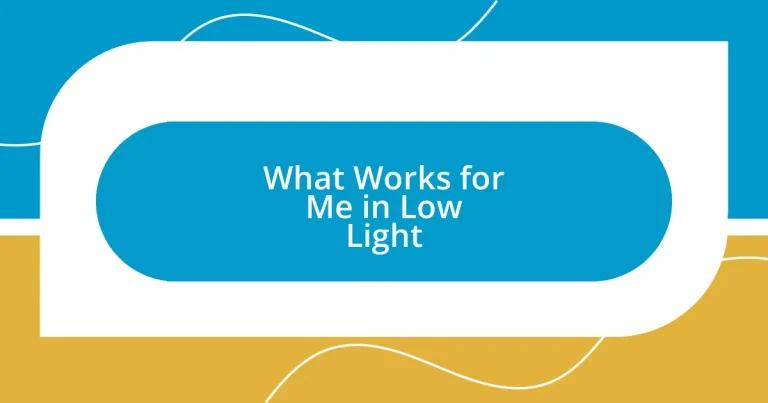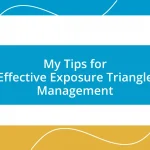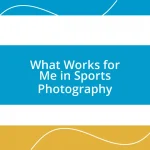Key takeaways:
- Low light photography requires understanding your equipment and adjusting settings like ISO, shutter speed, and aperture to capture emotions and details effectively.
- Essential tools for low light include a fast prime lens, tripod, external flash, and knowledge of camera settings to enhance image quality.
- Common mistakes involve neglecting stability with tripods, relying on automatic settings, and overlooking available light sources that can enrich photographs.
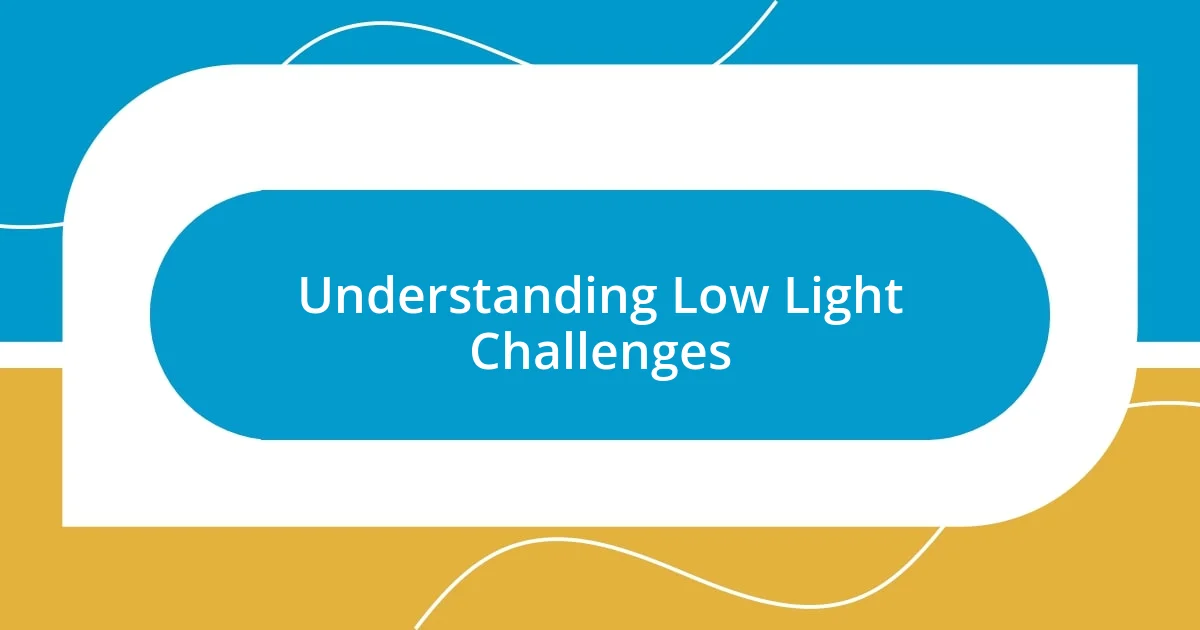
Understanding Low Light Challenges
Low light conditions can be particularly daunting, especially when I encounter a stunning sunset or the soft glow of evening lights. I often find myself wondering how to truly capture those moments without the right equipment. These low-light challenges often push me to rethink my approach, experimenting with different settings and techniques to reveal the beauty hidden in the shadows.
I remember one time at a concert; the ambiance was perfect, yet my camera struggled to adapt to the dim lighting. I was frustrated, wondering if my pictures would do justice to the experience. It was a disappointing moment, but I learned the importance of knowing my gear and understanding its limits in such challenging environments.
When I think about low light photography, I realize it’s more than just technical issues. It’s about conveying the emotion of the moment. How do we portray the warmth of candlelight or the chill of a starry night? These memories are vivid emotions captured in a frame, and adapting to low light to express them is what keeps my passion alive.
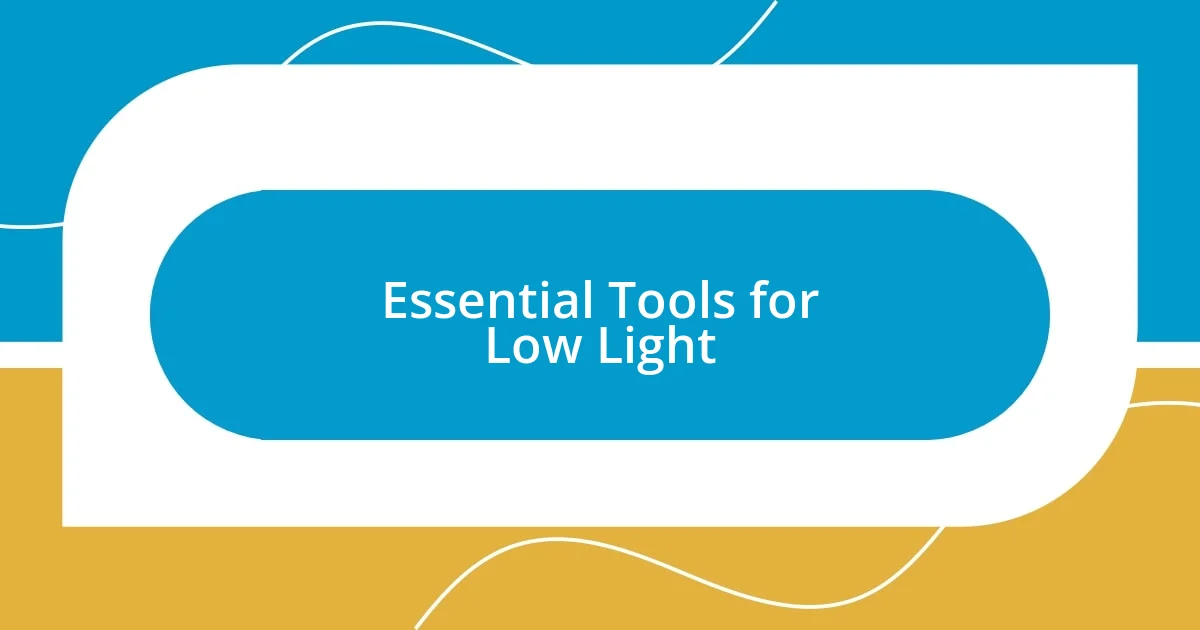
Essential Tools for Low Light
When diving into low light situations, I’ve found a few essential tools that make all the difference. Having the right gear can transform a frustrating experience into a captivating one. For instance, I always keep a lightweight, fast lens handy; it’s amazing how much a wider aperture can improve low light performance. I recall a night walk during a festival where my f1.8 lens allowed me to capture the vibrant colors and movement effortlessly, something I couldn’t have achieved with a standard kit lens.
Here are some tools I can’t live without for low light photography:
- Fast Prime Lens: A lens with a wide aperture (like f1.4 or f1.8) enhances light intake, resulting in clearer images.
- Tripod: Stabilizing your camera is crucial. A sturdy tripod allows for longer exposure times without blur.
- External Flash: Although it may feel counterintuitive, using a flash with diffusion can soften harsh light and create a more natural look in dark settings.
- Camera Settings Knowledge: Understanding ISO, shutter speed, and aperture helps in making quick adjustments during those fleeting moments.
- Remote Shutter Release or Timer: Reduces camera shake for sharp images when shooting at slower shutter speeds.
Each of these tools has played a role in my journey through low light, allowing me to embrace the beauty I encounter and translate my experience into stunning photographs.
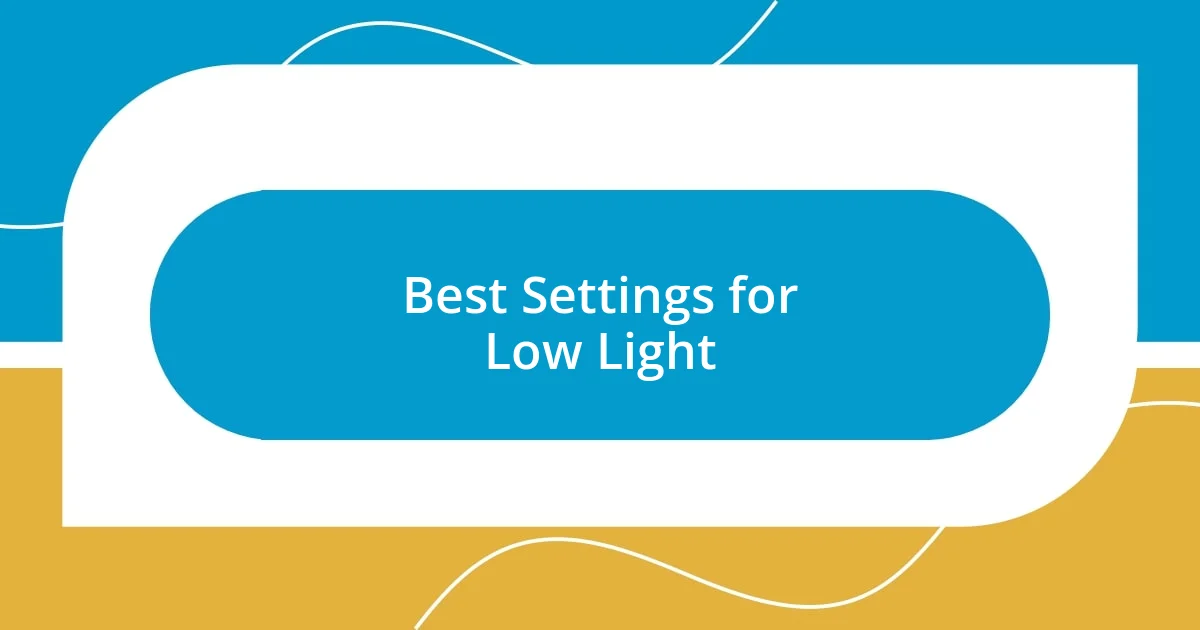
Best Settings for Low Light
When I’m shooting in low light, one of my go-to settings is increasing the ISO. I typically start around 800 and adjust as necessary. In a recent night market visit, I set my ISO to 1600 to capture the atmosphere without much grain. It’s fascinating how a higher ISO opens up the shadows and reveals details I wouldn’t have seen otherwise.
Next up is shutter speed. For me, keeping it around 1/60 seconds works well, but I adjust it based on the motion of my subjects. There was a moment during a friend’s wedding reception when I had to slow it down to 1/30 seconds to highlight the dancing guests. I was anxious about potential blur, but the results brought a dynamic feel to the photos, perfectly encapsulating the joyous spirit of the night.
Lastly, adjusting the aperture is crucial. I often shoot wide open (between f1.4 and f2.8) to let in every bit of light possible. It reminds me of a rainy evening when I captured the droplets on flower petals; the bokeh was gorgeous, turning a dull moment into a magical one. Finding these best settings allows me to better express the mood in those enchanting low-light scenarios.
| Setting | Recommended Value |
|---|---|
| ISO | 800 – 1600 |
| Shutter Speed | 1/60 – 1/30 seconds |
| Aperture | f1.4 – f2.8 |
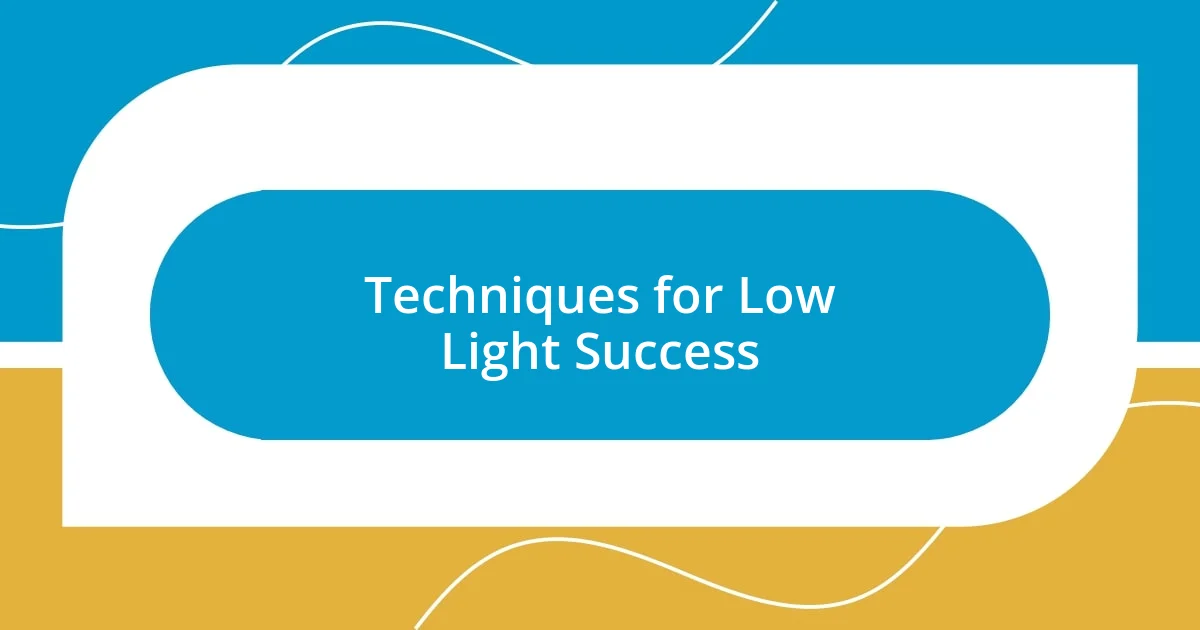
Techniques for Low Light Success
One technique that I swear by is pre-focusing in low light. It can be so challenging to get the right focus when the light is dim, which can lead to missed moments. I remember a candid shot of my niece blowing out her birthday candles; I focused on the cake first and then waited for the moment. Being prepared in this way not only eliminated the risk of focus hunting but also allowed me to capture that fleeting smile just in time.
Using a lens with image stabilization is another game-changer. I once attended a jazz concert and found myself standing at the back of a dimly lit venue. Without stabilization, I risked blurry shots from a shaky hand, which would have captured none of the soulful ambiance. Thankfully, my trusty lens kept everything sharp, letting me freeze those magical moments where the music truly came alive.
Lastly, try to anticipate the light’s movement and play with it. I vividly recall a sunset shoot at the beach where changing clouds transformed the scene every minute. By adjusting my positioning and angle relative to the fading light, I created a mesmerizing silhouette of a seagull gliding across the horizon. Isn’t it amazing how being flexible with your approach can turn a simple shot into something extraordinary? Embracing the unpredictability of low light often leads to the most stunning images.
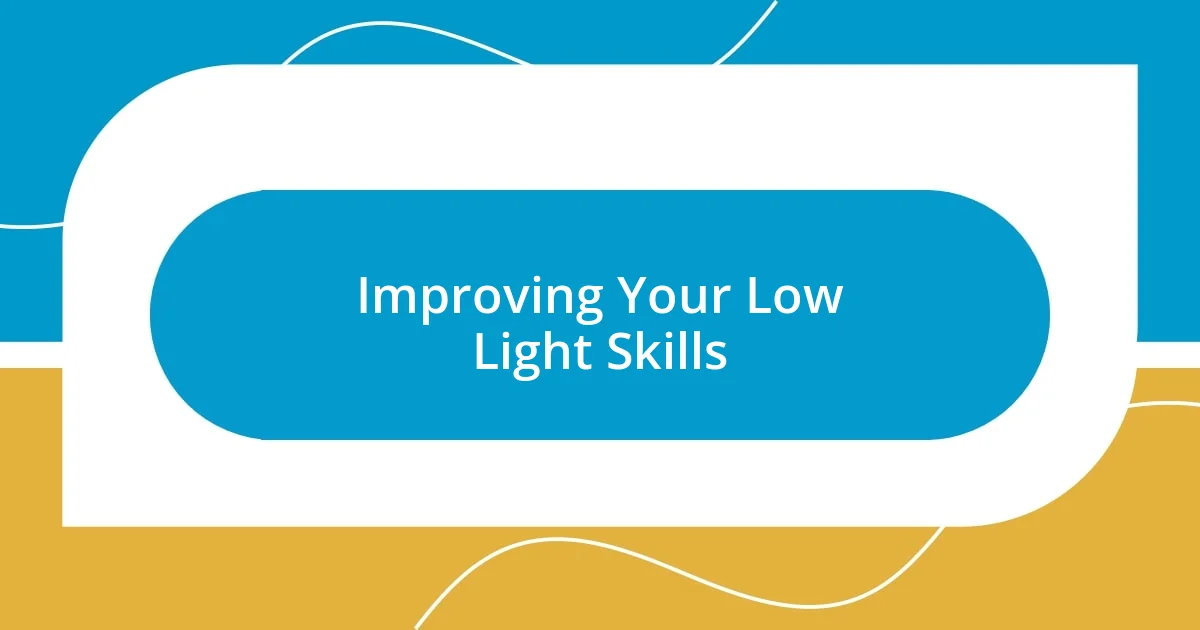
Improving Your Low Light Skills
Improving your low light skills is all about practice and experimentation. I once spent an evening wandering through a dimly lit art gallery, challenging myself to capture the artwork without flash. It forced me to rely on my intuition and adjust my settings on the fly. In the process, I learned to trust my instincts, which has been invaluable ever since. Can you remember the last time you pushed yourself out of your comfort zone? That growth is what makes every low-light venture worthwhile.
Another crucial aspect for me is understanding the environment. During a family gathering, I noticed how harsh overhead lights created unflattering shadows on faces. By repositioning my loved ones to benefit from the warm glow of nearby candles, I transformed those portraits into warm memories. Reflecting on that evening, I realized how essential it is to creatively use available lighting to enhance emotions and stories in my shots.
Lastly, I find that reviewing my shots immediately after taking them helps me improve swiftly. After an exhilarating late-night street photography session, I scrolled through my images, analyzing what worked and what didn’t. Each review revealed insights about composition, lighting nuances, and moments I might have missed. Have you ever taken the time to learn from your captures? It can be incredibly rewarding, helping you refine your technique for the next low-light adventure.
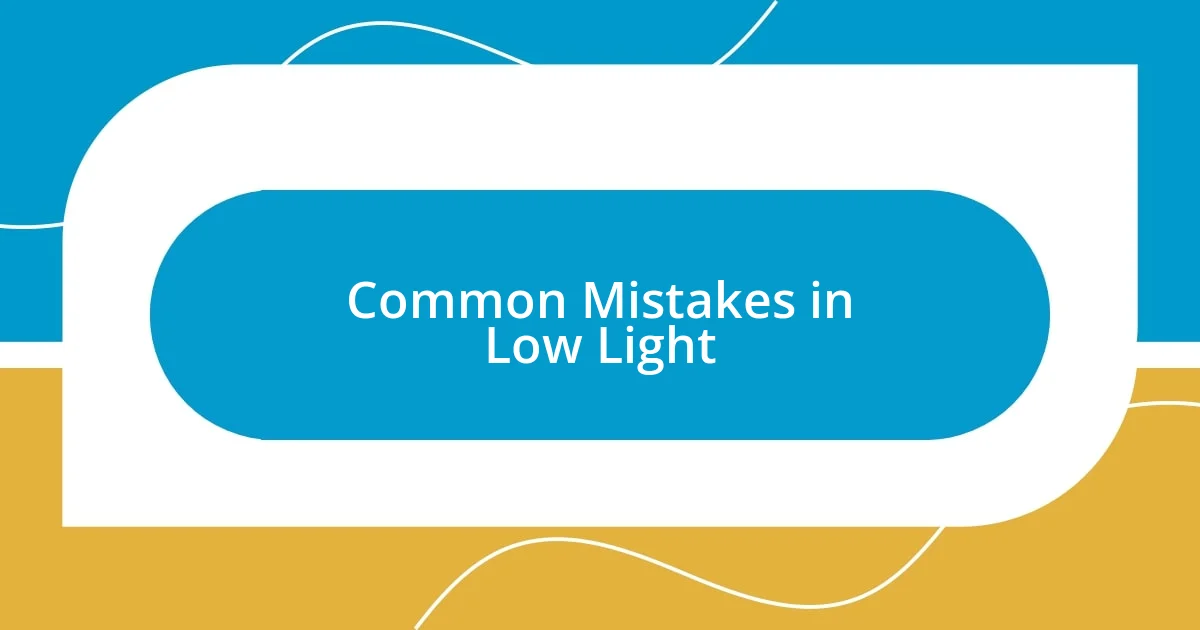
Common Mistakes in Low Light
It’s so easy to underestimate the importance of using a tripod in low light. I remember one chilly evening at a local park, excited to capture the night sky. Instead, I ended up with a series of blurry shots because I was too eager to shoot handheld. That experience really taught me that stability is key; even a slight movement can ruin an otherwise perfect capture. Have you ever felt that frustration when you knew the shot could have been incredible?
Another common mistake I’ve noticed is relying too heavily on the camera’s automatic settings. I recall a lively street fair where I assumed my camera could handle the dim lighting on its own. Unfortunately, my images came out dull and uninspired. By taking the time to learn manual settings, I realized I could bring out the vibrancy in those evening celebrations, capturing not just the scenes, but the atmosphere. Have you taken the leap into manual mode? It can be a game-changer.
One oversight I often see is ignoring the available light sources around us. During a friend’s wedding reception, I noticed many guests were trying to capture moments in dim corners with no consideration for the lovely fairy lights hanging above. When I finally directed them toward those twinkling lights, their expressions lit up, creating a much more enchanting backdrop. Reflecting on that night, I learned how critical it is to be aware of our surroundings — the right light can make all the difference. Do you keep your eyes open for unexpected light opportunities?

